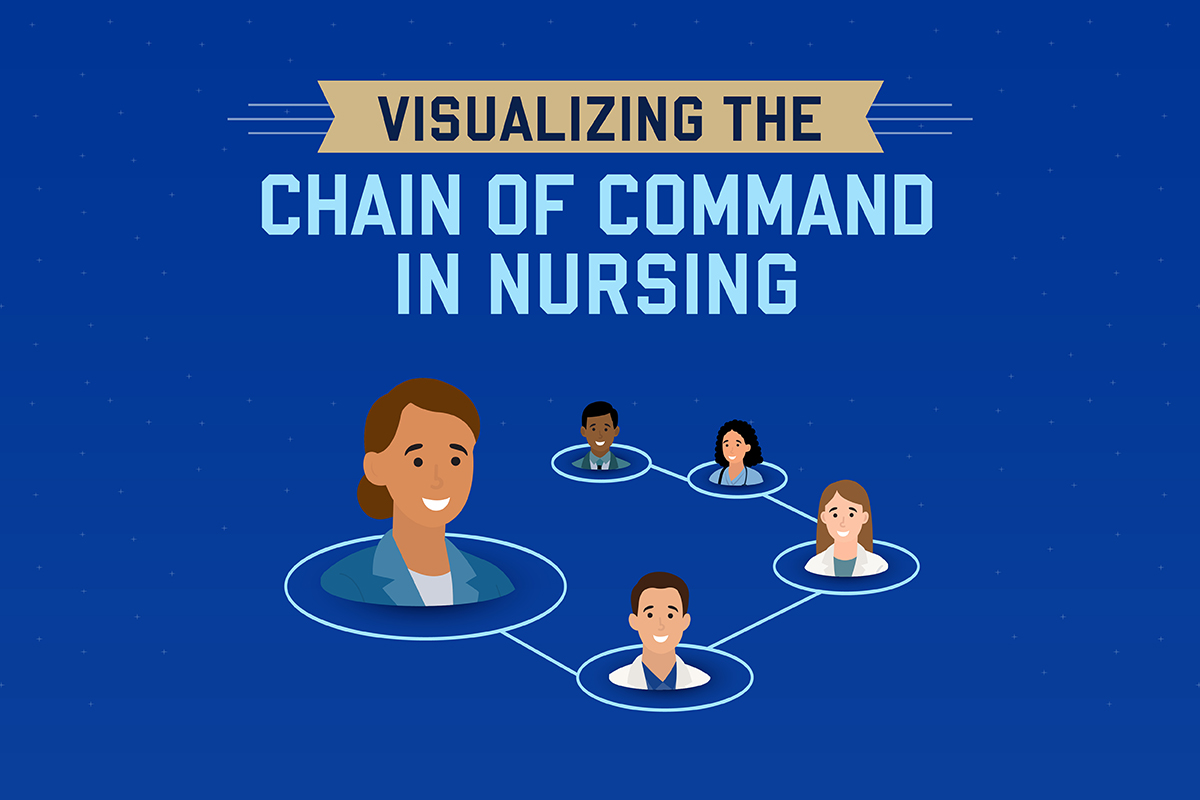Visualizing the Chain of Command in Nursing
Written by:
Tulsa University
• Oct 7, 2025

The military chain of command may be one of the most well known, but most workforces have their own hierarchy, and this includes nursing staff working in large facilities. The nursing hierarchy isn’t merely an ordered list of the ranks of nursing staff but rather is directly related to patient safety. Instructions or policies are passed down the chain, and questions or concerns about patient care are passed up the chain until they’re resolved.

Health care facility administrators and nursing staff need to know and follow the chain of command, while prospective nursing professionals and the general public can also benefit from understanding it.
To learn more, check out the infographic created by The University of Tulsa’s online Master of Science in Nursing (MSN).
Entry-Level Nursing
Entry-level nurses form the base of the nursing organizational chart. Below are three entry-level nursing roles, each requiring a different level of education.
Certified Nursing Assistant
Certified nursing assistants (CNAs) monitor patients’ vital signs and report any changes to their supervisor. CNAs also help patients with daily self-care tasks, including:
-
Eating and drinking
-
Bathing
-
Grooming
-
Dressing
-
Transferring between wheelchair or walker and bed
CNAs report to licensed practical nurses (LPNs) and registered nurses (RNs).
Licensed Practical Nurse
LPNs — known as licensed vocational nurses (LVNs) in California and Texas — provide basic patient care, including:
-
Dressing wounds
-
Maintaining patients’ records
-
Explaining care plans
-
Monitoring patients’ conditions
In some states, LPNs may have additional duties, such as starting IV lines or administering medication. Their duties may vary based on the type of facility they work in.
LPNs report to RNs.
Registered Nurse
RNs assist doctors and more advanced nurses in providing patient care. Their duties include:
-
Creating and maintaining patients’ charts
-
Examining patients
-
Performing medical tests and evaluating results
-
Educating patients about their condition and care plan
-
Assisting doctors with some procedures
In collaboration with doctors and advanced practice registered nurses (APRNs), RNs may help develop patients’ care plans.
RNs report to APRNs and charge nurses.
Nurse Management
Nurse managers oversee other nurses and set nurses’ schedules, and some work directly with patients. Nurses involved in patient care bring their concerns to these managers.
Charge Nurse
Charge nurses are RNs who oversee specific nursing units. Their responsibilities include:
-
Liaising between nurses and other health care professionals
-
Ensuring smooth operations and shift changes within nursing units
-
Assisting with staff scheduling and planning
-
Supporting nurses on their teams
Advanced Practice Registered Nurse
APRNs belong to one of four main types: nurse practitioner (NP), certified nurse-midwife (CNM), certified registered nurse anesthetist (CRNA), or clinical nurse specialist (CNS).
APRNs have more education than RNs, typically holding a Master of Science in Nursing (MSN) or a Doctor of Nursing Practice (DNP), and they work alongside rather than under doctors in many places.
Each type of APRN has specific duties. NPs act as primary care providers, performing more in-depth patient care tasks than RNs, including:
-
Examining patients
-
Ordering lab tests
-
Referring patients to specialists
-
Diagnosing diseases and medical conditions
-
Administering medication
-
Dispensing vaccines
-
Developing care plans
-
Explaining diagnoses and treatments to patients and their families
Depending on their state of practice, APRNs may need physician supervision, or they may be able to work independently.
APRNs report to directors of nursing and nursing administrators.
Director of Nursing and Nursing Administrator
Directors of nursing and nursing administrators have higher-level managerial roles than APRNs and charge nurses. Rather than caring for patients, they use their nursing education and experience to oversee patient care and run the nursing department.
Their duties include:
-
Recruiting, hiring, training, and evaluating nursing staff
-
Developing nursing budgets with the chief nursing officer (CNO), then managing those budgets
-
Overseeing patient care practices
-
Acting as a liaison between nurses and senior management
-
Handling patient data
Directors of nursing and nursing administrators report to the CNO.
Executive Leadership
The CNO sits at the top of the chain of command in nursing.
Chief Nursing Officer
CNOs have overall responsibility for all nursing services in a health care facility. They perform various administrative duties, including:
-
Coordinating with other hospital leaders to create standards of care
-
Developing department budgets
-
Establishing emergency procedures
-
Maintaining the facility’s staff-to-patient ratio
-
Handling the facility’s accreditation
-
Procuring new systems and equipment to improve efficiency
CNOs report to the hospital’s or system’s CEO.
Climb the Nursing Ladder
Understanding the chain of command in nursing can help aspiring nurses decide where they want to start their nursing career and visualize where additional education can take them. Others can benefit from understanding who makes the decisions regarding questions about patient care.
American Nurses Association, Charge Nurse vs. Nurse Manager: What’s the Difference?
Converys, “Chain of Command: A Powerful Patient Safety Tool”
CPH Insurance, “Know, And Follow, Your ‘Chain of Command’”
Creative Health Care Management, The C-Suite in Healthcare: Roles, Responsibilities, and Synergies
Indeed, Chief Nursing Officer Job Description
Indeed, Director of Nursing Job Description
Indeed, How to Become a Registered Nurse
Indeed, Learn How to Become an LPN
Indeed, Understanding the Nursing Hierarchy
Indeed, What Roles Can an Advanced Practice Registered Nurse Pursue?
U.S. Bureau of Labor Statistics, Licensed Practical and Licensed Vocational Nurses


